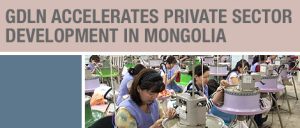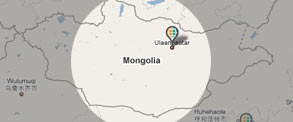Private Sector Development

Mongolia opened its economy less than 20 years ago. To compete globally, its companies had a lot to learn.
“Before, most Mongolian companies were the kind of big socialist industries,” said Sunji Jamba, the Global Development Learning Network representative in Mongolia. “To be competitive—both at the local level, regional level, and global level—private companies have to be competitive and operate more in an efficient way.”
The Eermel Cashmere and Textile Company is one of many large companies that needed to make the transition. After decades producing solely for the domestic market, it discovered that it was not yet equipped to meet the challenges of the international market.
“Since 1981, our company had only produced for the local market. We realized that we were not ready to meet global standards for quality and design,” said Densmaa, the Deputy Director for Production at Eermel (many Mongolians go by one name). “Today, I play a very important role to help the company produce high-quality goods for both the domestic and international markets.”
APPROACH
GDLN’s Japan affiliate organizes a course on business efficiency, entitled “Toyota Production Systems”
With the aim of helping many of its neighboring countries improve their business productivity, GDLN’s Japanese office began delivering a course entitled “Toyota Production Systems.”
Perhaps unsurprisingly, it became the most popular course in the history of the center.
“The objective of this course is to let people know about the theory of the Toyota Production System,” explained Eiko Wataya, with the GDLN office in Japan, “and then also to let people use their theory in their own context. The course was delivered to Mongolia, Vietnam, Philippines, Malaysia, Indonesia, Sri Lanka, Bangladesh, India, Cambodia, Iran—more than that, in total 14 countries.”
The course was designed and delivered by the Asian Productivity Organization (APO). Established in the early 1960s, the APO aims to contribute to the socioeconomic development of Asia and the Pacific through enhancing productivity.
“Basically, our program is human resources development,” said APO’s Director, Takuki Murayama, “and we are conducting training courses, seminars, workshops, and study missions—to contribute to the socioeconomic development of member countries in Asia and Pacific. So: productivity improvement.”
Murayama said that the GDLN has revolutionized the way APO does business. Whereas training used to cost about $4,000 per person, e-learning modules now average less than $300 per person. As a result, APO is reaching many more people, in more countries, with more courses.
But the education and outreach would never ring true without committed national partners who ensure the learning is appropriately local. That’s where Sunji Jamba came in.
“[GDLN] is a strong network, and we do get the best international practice,” said Jamba, who used her considerable contacts within Mongolia to attract 20 participants for the 2006 course and 20 more for the 2007 course. “From our side, we have added value to bring this content into a Mongolian context to adapt to the need of the Mongolian companies.”
To help with the localization of the content, Jamba invited the Mongolian National Productivity Development Center, APO’s local counterpart.
She also convened representatives from Mongolia’s largest companies, particularly engineering, mining, and textile companies—all of them were “very eager and very happy,” said Jamba.
As Jamba’s Tokyo-based collaborator, Wataya stressed that learning design was key to keeping the multiple-day course interesting. “Video conferencing is one of the good tools, but video conferencing is not everything. If we are talking about effective learning through ICT, we also have to look at the other tools to maximize the effect of the training.”
“The course continues for three days and then a part of these three days is allocated for the local company visit. In terms of the design, we called this a blended learning course.”
Densmaa, the deputy in charge of productivity at Eermel, the cashmere company, participated in the course. “In this training, my objective was to learn Toyota Production System principles—which are popular throughout the world—and to learn quickly how Mongolians can achieve similar success.”
After the site visit and the peer learning, she summed up what the group felt about the site visit. “We have a common expression: seeing once is better than hearing a thousand times.”
RESULTS
Through GDLN, Japan’s APO extends its capacity building regionally, and Mongolian companies become more competitive
APO is now delivering four e-learning courses in association with GDLN’s Tokyo office throughout the Asia Region—and will reach more than 1,200 people this year.
“When we started e-learning programs, we only had five countries involved, but these days out of 20 member economies, the number that is using this e-learning course is 15,” said Takuki Murayama. “I’m very happy we could develop a good relationship with [GDLN].”
By delivering such well-received e-learning courses to local private sector companies, Mongolia’s GDLN office has nurtured some loyal customers. “We have gained a lot of major local private companies as clients,” said Jamba.
“We target government officials and policymakers, but it is very important also to gain clients from the private sector in terms of the sustainability of [GDLN],” said Jamba. Another important partnership, added Jamba, is the one they’ve developed with the Asian Productivity Organization.
Perhaps most importantly, Mongolia’s companies are making progress. After taking the Toyota Production System course, Densmaa instituted new systems at Eermel. Consequently, the company is experiencing impressive growth.
“The result is that we’ve established better planning systems and are making better quality products,” Densmaa enthused. “From 2006 to 2007—without any technological innovation or hiring any new employees—our company’s revenue doubled.”
The Global Development Learning Network (www.gdln.org) is a partnership of over 120 centers in 80 countries that offer solutions to the knowledge and learning needs of clients around the world.
“Low bandwidth users may not be able to view the video”
To view video in French, click here.




